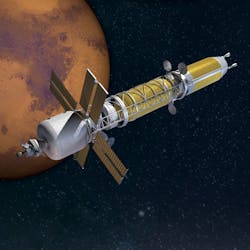Space Force picks Intuitive Machines to develop space nuclear power for small satellites and payloads
KIRTLAND AIR FORCE BASE, N.M. – U.S. Space Force power experts needed new approaches to space nuclear power generation for future propulsion and sensor payloads aboard small satellites. They found their solution from Intuitive Machines LLC in Houston.
Officials of the U.S. Air Force Research Laboratory Space Vehicle Directorate at Kirtland Air Force Base, N.M., announced a $33.7 million contract to Intuitive Machines in late September for the Joint Emergent Technology Supplying On-orbit Nuclear Power (JETSON) Low Power System program.
JETSON, which is part of the Space Technology Advanced Research - Fast-tracking Innovative Software and Hardware (STAR-FISH) initiative, seeks to develop enabling technologies for space-based radioisotope power systems.
Researchers are asking Intuitive Machines engineers to find new ways to develop compact radioisotope power systems, electric and hybrid propulsion for power conversion, power management, on-orbit mobility, thermal regulation, deployable structures, radiation shielding, and electronic hardening.
Related: DARPA and NASA select Lockheed Martin to develop nuclear-powered spacecraft
Today's pace systems are evolving from a few exquisite satellites to proliferated systems for persistent communications; intelligence, surveillance, and reconnaissance; positioning navigation and timing; space domain awareness; and space power.
The continuous power levels obtainable using space nuclear power may provide advantages over current solar electric power for mission payloads and spacecraft -- especially those relying on high delta-V electric propulsion, researchers explain.
Space nuclear power could enable a new generation of military small low-power applications that are not possible today. Work will involve integrating subsystem components, assessing technology readiness levels, component risk-reduction demonstrations, and model-based systems engineering models of a combined system of systems that uses space nuclear power.
Intuitive Machines experts will try to develop a space nuclear power design that balances electrical production with thermal dissipation overhead to reduce risk for near-term thermal radiator development for a navigation beacon in support of cislunar operations near NASA’s GATEWAY -- a future multi-purpose outpost orbiting the moon.
Such a system, which would be a 1U design that consumes five Watts or less, should be able to display orbital agility via a propulsion system able to operate for one year of mission operations, and for as long as two years of extended mission operations. Electric propulsion may consume as much as 15 Watts of power.
For more information contact Intuitive Machines online at www.intuitivemachines.com, or the Air Force Research Laboratory Space Vehicle Directorate at www.afrl.af.mil/RV.
About the Author
John Keller
Editor-in-Chief
John Keller is the Editor-in-Chief, Military & Aerospace Electronics Magazine--provides extensive coverage and analysis of enabling electronics and optoelectronic technologies in military, space and commercial aviation applications. John has been a member of the Military & Aerospace Electronics staff since 1989 and chief editor since 1995.
